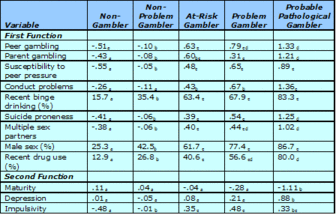In recent years, prolific research has unearthed an array of risk factors for gambling-related problems, but few studies have asked which risk factors are the most important or which risk factors should direct our prevention efforts. Answering these questions requires a comprehensive examination of risk factors for gambling-related problems to determine their relative contributions. In this WAGER, we report on a study by Langhinrichsen-Rohling et al. (2004) that used multivariate analysis to examine individual, family, and peer correlates of adolescent gambling.
Researchers recruited a convenience sample of 1,846 students from three high schools, each located in a different state. Students voluntarily completed a self-report packet which included the South Oaks Gambling Screen – Revised for Adolescents (SOGS-RA). Students also reported on demographic (e.g., sex, age), individual (e.g., binge drinking, truancy), family (e.g., parental gambling and drinking) and peer factors (e.g., peer gambling and behaviors). Invalid responders, inconsistent responders, incomplete responders and freshman were removed from analysis, yielding a final sample of 1,407 students. Using a classification scheme developed in a previous study (see Langhinrichsen-Rohling, Rohling, Rohde, & Seeley, in press), the researchers created five groups of students based on the SOGS-RA scores: (1) Non-Gamblers, (2) Non-Problem Gamblers, (3) At-Risk Gamblers, (4) Problem Gamblers, or (5) Probable Pathological Gamblers. The researchers used discriminant function analysis to determine whether the measured psychosocial factors could differentiate between the five groups.
Using univariate analyses, the researchers found 22 demographic, individual, family and peer variables that differed significantly across gambling classifications. However, when these variables were considered simultaneously in a discriminant function analysis, only 12 variables contributed meaningfully (i.e., accounted for 10% or more of the variance in the function) to functions predicting group membership1. These variables are listed in Table 1; the subscripts indicate significant univariate differences between groups. Nine variables loaded significantly on the first factor and increased in a linear fashion across the five gambling classifications: peer gambling, parent gambling, susceptibility to peer pressure, conduct problems, recent binge drinking, suicide proneness, having multiple sex partners, percent male, and recent drug use. Three variables loaded on to the second factor and were helpful in differentiating the Non-Gambler and Probable Pathological Gambler group from the rest: Non-Gamblers displayed greater maturity and less impulsivity, while Probable Pathological Gamblers were distinguished by greater levels of reported depression.
The two discriminant function solution correctly classified 43% of the students. The solution was less able to distinguish between students who were Non-Problem, At-Risk or Problem Gamblers (correctly classifying 40%, 31%, 36% respectively) and better able to distinguish students who fell into the extreme groups (Non-Gamblers, 71% and Probable Pathological Gamblers, 61%). When the researchers combined groups that were non-distinguished from each other (Non-Gamblers and Non-Problem Gamblers as one group, At-Risk and Problem Gamblers as the second group, and Probable Pathological Gamblers as the third group), this increased the classification accuracy to 72%.
Table 1. Standard Score Means and Percentages by Gambling Group for the Variables that Loaded† on the Discriminant Functions (taken from Langhinrichsen-Rohling et al., 2004).

Note: subscripts represent the results of post-hoc comparisons: groups that share the same subscript do not differ significantly from each other, whereas groups with different subscripts do.
† Variables that loaded at or above .33 (i.e., accounted for at least 10% of the variance) on one of the two functions were included.
The authors highlight several limitations to their study: (1) its cross-sectional nature prohibits causal interpretations, (2) the use of self-report measures yields perceptions of behaviors (e.g., perceptions of peer gambling) instead of objective measures, and (3) the results may not be generalizable to students in different socioeconomic or geographic areas, or to adolescents who are not in school. Interestingly, the authors found that impulsivity was associated with gambling, but discriminated only non-gamblers from gamblers. This would suggest that impulsivity could predict who will experiment with gambling, but not necessarily who will develop problems.
This finding is contrary to other research in the field that points to impulsivity as a risk factor for problem development and deserves further investigation.
Many of the psychosocial variables examined had previously been linked to gambling behavior individually. However, by using discriminant factor analysis the authors were able to examine these variables simultaneously to reveal their relative contributions. This type of analysis enables researchers and clinicians to focus on those factors that are most important and prevents them from diverting time and resources towards relatively inconsequential factors. The current research suggests that gamblers with the most serious problems are more likely to engage in other risky behaviors (binge drinking, multiple sex partners, conduct problems, recent drug use). Therefore, interventions might be most appropriately targeted to individuals exhibiting a wide range of risky behaviors, not gambling alone. Further, family and peer behaviors appear to influence the development of problem gambling, and thus interventions or educational sessions might need to cast a wider net, perhaps by engaging family members in outreaches.
Comments on this article can be addressed to Rachel Kidman
Notes
1 Variables that did not load on the discriminant functions were race, early cigarette use, masculine role orientation, grade point average, truancy, lifetime suicide attempt, peer risky behavior, family cohesions, and parent drinking.
References
Langhinrichsen-Rohling, J., Rohde, P., Seeley, J. R., & Rohling, M. L. (2004). Individual, Family, and Peer Correlates of Adolescent Gambling. Journal of Gambling Studies, 20(1), 23-46.
Langhinrichsen-Rohling, J., Rohling, M. L., Rohde, P., & Seeley, J. R. (in press). The SOGS-RA versus the MAGS-7: Variations in adolescent gambling prevalence rates as a function of measurement device and geographic location. Journal of Gambling Studies.




